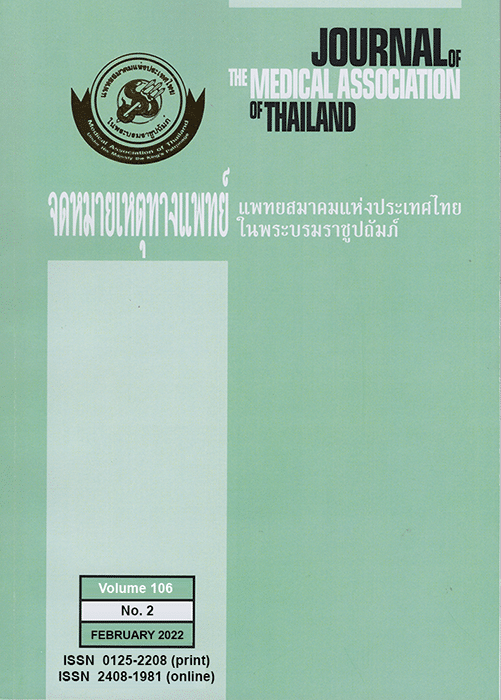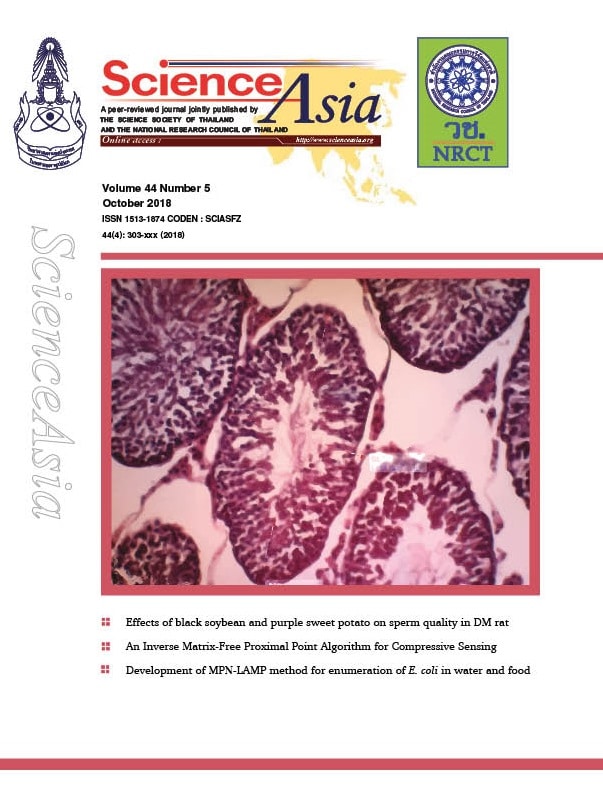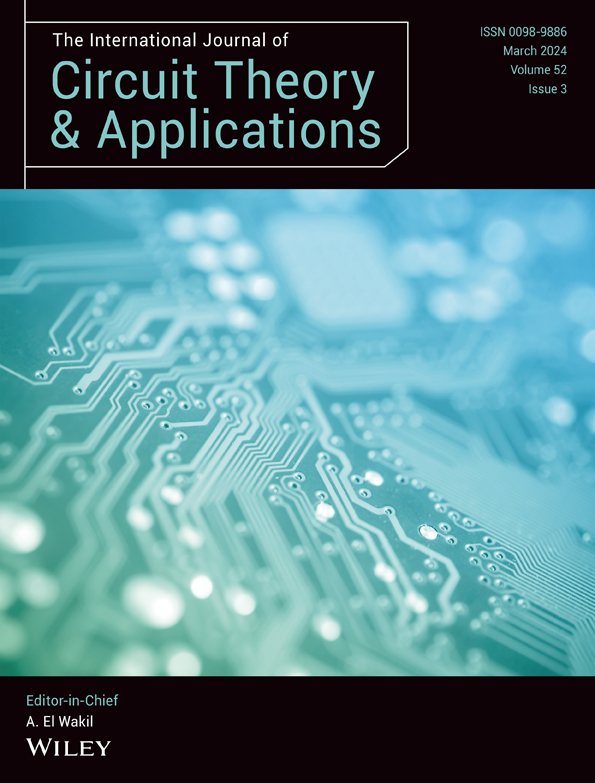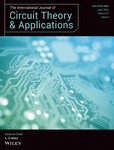
Noise analysis of electrical circuits on fractal set (2022)
Title : Noise analysis of electrical circuits on fractal set
Researcher : Banchuin, R.
Department : Faculty of Engineering, & Graduated School of IT, Siam University, Bangkok, Thailand
Email : rawid.ban@siam.edu
Abstract :
Purpose
Design/methodology/approach
Findings
Originality/value
Link to article : COMPEL – The International Journal for Computation and Mathematics in Electrical and Electronic Engineering, 2022, 41(5), pp. 1464–1490. https://doi.org/10.1108/COMPEL-08-2021-0269
Journal : COMPEL – The International Journal for Computation and Mathematics in Electrical and Electronic Engineering / in Scopus
Citation : Banchuin, R. (2022). Noise analysis of electrical circuits on fractal set. COMPEL – The International Journal for Computation and Mathematics in Electrical and Electronic Engineering, 41(5), 1464–1490. https://doi.org/10.1108/COMPEL-08-2021-0269
ฐานข้อมูลงานวิจัย มหาวิทยาลัยสยาม : https://e-research.siam.edu/kb/noise-analysis-of-electrical-circuits/

Nomogram of cervical length at mid-trimester in normal thai pregnant women (2018)
Title : Nomogram of cervical length at mid-trimester in normal thai pregnant women
Researcher : Kovavisarach, E., Sukontaman, W.
Abstract : Background:As cervical length decreases in the second trimester, the risk of spontaneous preterm birth increases, especially when effacement occurs early in the second trimester, and it is often detected on ultrasound examination before it can be identified by physical examination. To date, only two Thai nomograms of transvaginal cervical length have been reported.
Objective: To establish a new Thai nomogram as a reference for evaluation of transvaginal cervical length in a tertiary Thai hospital in Bangkok (Rajavithi Hospital: RH) during gestational age (GA) 16 to 24 weeks.
Material and Method: This research was approved by the ethics committee of RH (No. 055/2558). A total of 286 normal Thai pregnant women who attended the antenatal clinic (ANC) at RH between May 1, 2015 and November 30, 2015 were included. All were cases of singleton gestation with no medical or obstetric complications and no fetal congenital anomalies; and all had GA confirmed by Crown Rump Length (CRL) before GA of 14 weeks. Cervical length measurement was performed by a single operator using transvaginal ultrasonography (7.5 mHz Voluson E8) during GA of 16 to 24 weeks. The subjects attended follow-up sessions in the antenatal care clinic until delivery.
Results:One hundred and ninety-six cervical measurements were analysed (90 patients were excluded: 7 because of preterm labor, and 83 because they were lost to follow-up). The mean maternal age was 29.49+6.5 years, and the most common pregnancy status was nullipara (48.3%). The mean CL of nulliparous, multiparous and overall women were 37.87, 39.46 and 38.70 mm respectively. The CL values were constant during the examined GA.
Conclusion:The mean cervical length of normal Thai pregnant women between GA of 16 to 24 weeks examined transvaginally
was 38.70 mm.
Keywords: Cervical length (CL), Transvaginal ultrasonography
Link to Academic article: http://www.jmatonline.com/index.php/jmat/article/view/9091
Journal : Journal of the Medical Association of Thailand, 2018, 101(Suppl.2)
Bibliography : Kovavisarach, E., & Sukontaman, W. (2018). Nomogram of cervical length at mid-trimester in normal thai pregnant women. Journal of the Medical Association of Thailand, 101(Suppl.2), S31–S37.

Nongenomic action of aldosterone on colocalization of angiotensin II type 1 and type 2 receptors in rat kidney (2018)
Title : Nongenomic action of aldosterone on colocalization of angiotensin II type 1 and type 2 receptors in rat kidney
Researcher : Sinphitukkul, K., Manotham, K., Eiam-Ong, S., Eiam-Ong, S.
Abstract : Previous in vitro studies have demonstrated that angiotensin II type 1 and type 2 receptors (AT1R and AT2R) are co-localized and can form AT1R/AT2R dimerization in rat proximal tubular cells. Aldosterone non-genomically enhances angiotensin II receptor dimerization. We found no other in vivo studies in the literature regarding the effect of aldosterone on colocalization of AT1R and AT2R in whole kidney. Male Wistar rats were intraperitoneally injected with either normal saline solution (sham group) or aldosterone (experimental group). Colocalization of renal AT1R and AT2R proteins was examined by double immunohistochemical staining. The colocalization of AT1R and AT2R proteins was more prominent in the glomerulus, distal convoluted tubules, and cortical collecting ducts while colocalization was weak and diffused in the proximal convoluted tubules and peritubular capillaries in both groups. Our in vivo study showed aldosterone did not alter a constitutive colocalization of AT1R and AT2R proteins in the renal cortex and medulla. However, these proteins were colocalized more prominently in the renal cortex.
Keywords: Aldosterone, angiotensin II receptors, nongenomic action, protein colocalization, rat kidney
Link to Academic article: https://doi.org/10.1080/01478885.2018.1438756
Journal : Journal of Histotechnology, 2018, 41(2).
Bibliography : Sinphitukkul, K., Manotham, K., Eiam-Ong, S., & Eiam-Ong, S. (2018). Nongenomic action of aldosterone on colocalization of angiotensin II type 1 and type 2 receptors in rat kidney. Journal of Histotechnology, 41(2), 58–65.

Nongenomic effect of aldosterone on angiotensin II type 1 receptor dimerization in human renal proximal tubular cells: Implications for endoplasmic reticulum stress (2018)
Title : Nongenomic effect of aldosterone on angiotensin II type 1 receptor dimerization in human renal proximal tubular cells: Implications for endoplasmic reticulum stress
Researcher : Sinphitukkul, K., Manotham, K., Eiam-Ong, S., …Inagi, R., Eiam-Ong, S.
Abstract : In vitro studies have showed that aldosterone increases oxidative stress molecules through a nongenomic effect. Oxidative stress induces angiotensin II type 1 receptor (AT1R) dimerization and endoplasmic reticulum (ER) stress, leading to renal tubular damage. However, the nongenomic effect of aldosterone on AT1R dimerization and ER stress in renal cells has not been determined. Here, we examined the nongenomic action of aldosterone in renal proximal tubular epithelial cells (PTECs) to better understand the underlying mechanisms. HK-2 cells, human renal PTECs, were exposed to vehicle or aldosterone for 30 min. In two additional groups, the cells were pretreated with eplerenone, a mineralocorticoid receptor (MR) blocker or apocynin, an NADPH oxidase inhibitor, for 30 min before aldosterone incubation. Protein abundances of dimeric/monomeric forms of AT1R, p47phox (a cytosolic part of NADPH oxidase), and activating transcription factor 4 (ATF4), a transcription factor responsive to ER stress, were determined by Western blotting. Aldosterone nongenomically increased plasma membrane protein expression of AT1R dimeric forms in a time- and dose-dependent manners. The levels of the cytosolic p47phox protein declined while the membranous protein level was enhanced following aldosterone treatment. The aldosterone induced alteration in these two proteins was abolished by pretreatment with eplerenone or apocynin. In addition, aldosterone (100 nM) induced nuclear ATF4 protein accumulation in a time-dependent fashion, which was blocked by apocynin and partially attenuated by eplerenone. Aldosterone nongenomically increased AT1R dimerization and nuclear ATF4 protein accumulation dependent on MR and NADPH oxidase activation. Hence aldosterone could induce AT1R dimerization and activate the endoplasmic reticulum stress response.
Link to Academic article: doi: 10.2306/scienceasia1513-1874.2018.44.332
Journal : ScienceAsia, 2018, 44(5).
Bibliography : Sinphitukkul, K., Manotham, K., Eiam-Ong, S., Nangaku, M., Inagi, R. & Eiam-Ong, S. (2018). Nongenomic effect of aldosterone on angiotensin II type 1 receptor dimerization in human renal proximal tubular cells: Implications for endoplasmic reticulum stress. ScienceAsia, 44(5), 332–339.

Nonlocal fractal calculus based analyses of electrical circuits on fractal set (2022)
Title : Nonlocal fractal calculus based analyses of electrical circuits on fractal set
Researcher : Banchuin, R.
Department : Faculty of Engineering, & Graduated School of IT, Siam University, Bangkok, Thailand
Email : rawid.ban@siam.edu
Abstract :
Purpose
Design/methodology/approach
Findings
Originality/value
Link to article : COMPEL – The International Journal for Computation and Mathematics in Electrical and Electronic Engineering, 2022, 41(1), 528–549. https://doi.org/10.1108/COMPEL-08-2021-0269
Journal : COMPEL – The International Journal for Computation and Mathematics in Electrical and Electronic Engineering / in Scopus
Citation : Banchuin, R. (2022). Nonlocal fractal calculus based analyses of electrical circuits on fractal set. COMPEL – The International Journal for Computation and Mathematics in Electrical and Electronic Engineering, 41(1), 528–549. https://doi.org/10.1108/COMPEL-08-2021-0269
ฐานข้อมูลงานวิจัย มหาวิทยาลัยสยาม : https://e-research.siam.edu/kb/nonlocal-fractal-calculus/

Obstetric and Neonatal Outcomes of Excessive Weight Gain in Different Pre-Pregnancy Body Mass Index using BMI Criteria for Asians by World Health Organization Western Pacific Region (WPRO) (2020)
Title : Obstetric and Neonatal Outcomes of Excessive Weight Gain in Different Pre-Pregnancy Body Mass Index using BMI Criteria for Asians by World Health Organization Western Pacific Region (WPRO)
Researcher : Somprasit, C., Tanprasertkul, C., Nanthakomon, T., Kovavisarach, E., Rattanasiri, T.,… Saksiriwutth, P.
Abstract : Objective: To evaluate the relationship between gestational weight gain and pre-pregnancy body mass index (BMI) on the risk of adverse obstetric and neonatal outcomes using cut off BMI criteria by Regional Office for the Western Pacific Region of WHO (WPRO).
Materials and Methods: The present study was a retrospective cohort. Subjects of live birth singletons who had full term delivered at four tertiary care centers, teaching university hospitals between January and December 2012 were enrolled. All pregnant women with pre-pregnancy BMI 18.5 kg/m2 or over were recruited and categorized into two groups, normal BMI and high BMI. The level of BMI at 18.5 to 22.9 kg/m2 was defined as normal BMI, and level at or over 23 kg/m2 was defined as high BMI, respectively. Gestational weight gain (GWG) was grouped into two categories as recommended weight gain (RWG) and excessive weight gain (EWG) which defined as 11.5 to 16 kg and above 16 kg in normal pre-pregnancy BMI and 5 to 9 kg and above 9 kg in high prepregnancy BMI, respectively. The association between RWG and EWG in different pre-pregnancy BMI groups and poor adverse pregnancy outcomes were evaluated.
Results: Two thousand seven hundred and thirty-three pregnant women were recruited. Normal and high pre-pregnancy BMI women were 1,840 (67.33%) and 893 (32.67%), respectively. Of these, 2,036 cases had complete data for evaluation. In normal prepregnancy BMI, 737 (59.58%) were categorized as RWG (11.5 to 16 kg) and 500 (40.42%) as EWG (>16 kg), while in high prepregnancy BMI, 273 (34.17%) were categorized as RWG (5 to 9 kg) and 526 (65.83%) as EWG (>9 kg). The mean weight gain in the normal pre-pregnancy BMI group was 13.80+1.35 kg vs. 20.39+3.84 kg in the RWG and EWG group, respectively. While the mean weight gain in high pre-pregnancy BMI group was 7.32+1.38 kg vs. 15.24+4.46 kg in the RWG and EWG group, respectively. In multivariate logistic analysis, normal pre-pregnancy BMI group with EWG had increased risk of instrumental delivery or cesarean section (Odd ratio; with OR 1.06, 95% CI 1.03 to 1.08, p<0.001) and high pre-pregnancy BMI group with EWG, there was significant\ increased risk of preeclampsia with birth weight above 90th centile (OR 1.09, 95% CI 1.04 to 1.15 and OR 1.09, 95% CI 1.06 to 1.12 with p = 0.001 and <0.001, respectively).
Conclusion: For pregnant women with high pre-pregnancy BMI by WPRO criteria increased the risk of pregnancy complications and adverse pregnancy outcomes especially in excessive weight gain women. The high pre-pregnancy BMI should be a concern for pre-conception counseling. Optimal GWG ranges should develop based on pre-pregnancy BMI cut off for Asian women.
Keywords: Neonatal birth weight, Gestational weight gain, Pre-pregnancy BMI, WPRO
Link to Academic article: http://www.jmatonline.com/index.php/jmat/article/view/11079
Journal : Journal of the Medical Association of Thailand, 2020, 103(Suppl.4)
Bibliography : Somprasit, C., Tanprasertkul, C., Nanthakomon, T., Vinayanuvattikhun, N., Kovavisarach, E., Panichakul, P.,… Saksiriwutth, P. (2020). Obstetric and Neonatal Outcomes of Excessive Weight Gain in Different Pre-Pregnancy Body Mass Index using BMI Criteria for Asians by World Health Organization Western Pacific Region (WPRO). Journal of the Medical Association of Thailand, 103(Suppl.4), 88–93.

On the analytical modeling of fractal memelement and inverse memelement (2024)
Title : On the analytical modeling of fractal memelement and inverse memelement
Researcher : Banchuin, R.
Department : Faculty of Engineering, Siam University, Bangkok, Thailand
Email : rawid.ban@siam.edu
Abstract : In this work, an improved analytical model of fractal memelement in which the pinched point shifting has been considered and the original analytical model of fractal inverse memelement have been proposed. These fractal circuit elements are the memelement, and inverse memelement operates based on the principle of electromagnetic in fractal time/space, which must be applied whenever the current flows through fractal media. These models are important because these memory elements can be realized based on the porous material, which is a fractal media. In addition, they can employ self-similarity, which is hard to be simulated by using the traditional models. This is because such self-similarity can be well explained by the fractal set-based model, yet those traditional models are based on the set of real values. Therefore, for deriving the proposed models, the fractal calculus, which is oriented to the fractal set, has been adopted as the mathematical basis. From the analytical and numerical analyses based on the derived models, it has been found that both memelement and inverse memelement can retain their unique frequency characteristics despite being operated based on the abovementioned principle. In addition, their input–output relationships are mathematically differentiable albeit the inputs and outputs themselves are not.
Link to article : International Journal of Circuit Theory and Applications, Version of Record online: 26 March 2024 https://doi.org/10.1002/cta.4023
Journal : International Journal of Circuit Theory and Applications / in Scopus
Bibliography : Banchuin, R. (2024, March 26). On the analytical modeling of fractal memelement and inverse memelement. International Journal of Circuit Theory and Applications, Version of Record online. https://doi.org/10.1002/cta.4023

On The Fractional Domain Analysis of HP TiO2 Memristor Based Circuits with Fractional Conformable Derivative (2021)
Title : On The Fractional Domain Analysis of HP TiO2 Memristor Based Circuits with Fractional Conformable Derivative
Researcher : Banchuin, R.
Department : Faculty of Engineering, & Graduated School of IT, Siam University, Bangkok, Thailand
Email : rawid.ban@siam.edu
Abstract : For the first time, the physical memristor-based circuits i.e., HP TiO2 memristor-based circuits, of both series and parallel structures, have been extensively analyzed in the fractional domain by means of the state of the art yet simple fractional conformable derivative-based differential equations. Different outcome from the hypotheticalmemory element-based previous researches have been obtained. The dimensional consistencies of the fractional derivatives have also been concerned. The often-cited Joglekar’s window function has been adopted for modelling the boundary effect of the memristor and adding more nonlinearity close to the bounds of the memristor’s state variable. The formulated fractional differential equations have been solved and the related electrical quantities have been determined. The computational simulations have been performed. The stability analyses of both circuits have also been presented where it has been mathematically verified that only these HP TiO2 memristor-based circuits are stable always due to the boundary effect which does not exist in hypothetical elements assumed in those previous works. We also point out that that only those HP TiO2 memristor-based circuits of order higher than 3 are capable to exhibit the complex dynamics as such memristor lacks the local activity.
Link to article : Cogent Engineering, 2021, 8(1), 1986198. https://doi.org/10.1080/23311916.2021.1986198
Journal : Cogent Engineering / in Scopus
Citation : Banchuin, R. (2021). On the fractional domain analysis of HP TiO2 memristor based circuits with fractional conformable derivative. Cogent Engineering, 8(1), 1986198. https://doi.org/10.1080/23311916.2021.1986198
ฐานข้อมูลงานวิจัย มหาวิทยาลัยสยาม : https://e-research.siam.edu/kb/on-the-fractional-domain/

On the fractional domain analysis of negative group delay circuits (2024)
Title : On the fractional domain analysis of negative group delay circuits
Researcher : Banchuin, R.
Department : Faculty of Engineering, Siam University, Bangkok, Thailand
Email : rawid.ban@siam.edu
Abstract : In this work, the analysis of negative group delay circuits in fractional domain has been conducted. The low pass and the high pass negative group delay circuits constructed based on passive network have been chosen as our candidate circuits. For performing the analysis in fractional domain, the novel Caputo–Fabrizio derivative-based fractional impedance have been introduced to both circuits. The crucial parameters, the necessary conditions, and the existence conditions of both candidate negative group delay circuits have been formulated. The simulations have been conducted based on the formulated results where the comparisons with the conventional prototypes have been made. The verifications by the proof-of-concept circuits have also been performed. In addition, the effects of variation in the order of fractional impedances have been investigated. In summary, it has been found that considering these negative group delay circuits in the fractional domain, which effectively taking unavoidable nonidealities that cannot be modeled in conventional domain into account, significantly alters their characteristics especially the low pass circuit. However they can retain their low pass and high pass negative group delay functions.
Link to article : International Journal of Circuit Theory and Applications, 2024, 52(3), pp. 1531–1546 https://doi.org/10.1002/cta.3819
Journal : International Journal of Circuit Theory and Applications / in Scopus
Bibliography : Banchuin, R. (2024). On the fractional domain analysis of negative group delay circuitsd. International Journal of Circuit Theory and Applications, 52(3), 1531–1546 https://doi.org/10.1002/cta.3819

On the noise performances of fractal-fractional electrical circuits (2023)
Title : On the noise performances of fractal-fractional electrical circuits
Researcher : Banchuin, R.
Department : Faculty of Engineering & Graduated School of IT, Siam University, Bangkok, Thailand
Email : rawid.ban@siam.edu
Abstract : In this work, the noise performances of the fractal-fractional electrical circuits have been addressed. The nonlocal fractal calculus has been adopted as our mathematical basis. The fractal time component has also been included for the physical measurability of electrical quantities. The derivations of crucial stochastic parameters of circuit responses, which determine their noise performances, have been performed. Numerical simulations have also been conducted where the influences of Hausdorff dimension of the fractal set, orders of fractal-fractional reactive components, and other parameters on the noise performances have been studied. Regardless to any specific circuit, we have found that the noise performances can be improved by increasing the orders of fractal-fractional reactive components. The optimum Hausdorff dimensions, which the best noise performances can be achieved given the orders of fractal-fractional reactive components, have also been calculated. The results proposed in this work serve as the foundation for understanding noise in fractal-fractional electrical circuits and can be extensively applied to large-scaled circuits, for example, the infinite circuit networks and so forth.
Link to article : International Journal of Circuit Theory and Applications, 2023, 51(1), pp. 80–96. https://doi.org/10.1002/cta.3407
Journal : International Journal of Circuit Theory and Applications / in Scopus
Bibliography : Banchuin, R. (2023). On the noise performances of fractal-fractional electrical circuits. International Journal of Circuit Theory and Applications, 51(1), 80–96. https://doi.org/10.1002/cta.3407
ฐานข้อมูลงานวิจัย มหาวิทยาลัยสยาม : https://e-research.siam.edu/kb/on-the-noise-performances/